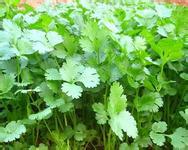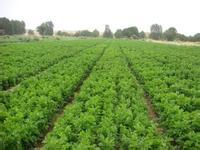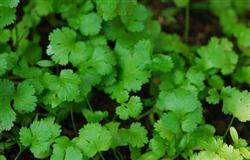Interplanting cultivation techniques of Pepper, towel Gourd and coriander

Interplanting towel gourd and coriander in greenhouse can make rational use of greenhouse space. 3000 kg per mu of chili, 1500-1800 kg of towel gourd and 550600 kg of parsley have considerable economic benefits. Now the cultivation techniques are introduced as follows: first, variety selection of early-maturing pepper variety Wanjiao 4 or Sujiao 5, towel gourd selected five-leaf towel gourd, parsley selected large-leaf parsley. Second, the strong seedlings of pepper were raised in the cold bed in the greenhouse from late October to the first and middle of November, and the towel gourd was raised in the nutrition bowl in the first and middle of March. The pepper seeds were disinfected with 55 ℃ 0.1% potassium permanganate solution for 10 minutes, washed and soaked in 25 ℃ warm water for 3-4 hours, drained, moisturized and germinated at 28 ℃. When 70% of the seeds are white, they can be sown in the seedbed. The towel gourd seeds were soaked in warm water for 3 hours, then wrapped with gauze and placed at a temperature of 30 ℃ to accelerate germination. After breaking the mouth, the seeds could be sown in a nutrition bowl. Before sowing, rub the coriander into the seed ball, soak the seeds in clean water for 6-8 hours, and hang the seeds above the surface of the well to accelerate germination. 3. Seedling bed management when pepper seedlings have 2 leaves and 1 heart, the seedlings are divided into 8 cm × 10 cm nutrition bowls. During the overwintering period, large sheds with small arched sheds and grass curtains are used to cover against cold and freezing, and watering is controlled in winter to avoid excessive humidity of the seedling bed. The daily temperature is controlled at 20-25 ℃ and the night temperature is above 15 ℃. Pay attention to timely ventilation in sunny days. After the Beginning of Spring, the ground temperature gradually rises, and dilute water and manure are applied properly. 0.2% potassium dihydrogen phosphate solution can be sprayed to promote seedling growth, and carbendazim, thiophanate and chlorothalonil are properly sprayed to prevent diseases. The seedling age is 100-120 days, the leaves are dark green, and most of the buds can be planted. Before emergence, the daily temperature of towel gourd was controlled at 25-30 ℃, and the night temperature was 18-20 ℃. After emergence, the temperature was ventilated in time. The seedlings are 35-40 days old and can be planted with 3-5 true leaves per plant. The surface of parsley is covered with sunshade net after sowing, and the hot and dry weather insists on spraying water sooner or later, keeping the soil moist and promoting seedling emergence. 4. Reasonable interplanting pepper was planted in the greenhouse in the morning on a sunny day in the first ten days of March. 4500 plants were planted per mu with a row spacing of 30 cm × 45 cm. 7-10 days before planting, 4000-5000 kg of rotten farm manure, 50 kg of cake fertilizer and 25 kg of ternary compound fertilizer were applied per mu. Close the shed for 5-7 days after planting, keep warm and moisturize, and promote slow seedling. Towel gourd was planted between pepper rows in late April and was close to the inner side of the foot of the scaffolding. 2 rows were planted in each shed and 220-250 plants per mu. Coriander in late July after pulling pepper seedlings, timely soil preparation and fertilization, 20 kg per mu of compound fertilizer, 2000 kg of mature farm manure, sowed under the towel gourd rack. Fifth, timely field management should adjust the greenhouse temperature reasonably and apply fertilizer and water skillfully according to the growth process of hot pepper. Before setting fruit, ventilation should be timely in sunny day, heat preservation and frost protection should be properly covered at night, high temperature should be prevented from damaging seedlings in sunny day, greenhouse temperature should be controlled at 25-28 ℃ in daytime and 15-18 ℃ at night. According to the growth trend, 1500-2000 kg of dilute water dung per mu plus 7.5kg of urea for a total of 2-3 times. Combined with pest control, 0.2% potassium dihydrogen phosphate or Tianyuan liquid fertilizer was sprayed outside the root for 2-3 times. The small shed was removed in late April and the large boron film was removed in late May. After June, attention should be paid to clearing ditches and regulating soil moisture, drainage and waterlogging. Towel gourd in the early stage of vine extension, first insert a short bamboo pole next to the scaffolding, after the plastic film of the greenhouse is removed in late May, draw the vine, manage the vine, bind the vine in time, and make it climb along the bamboo pole onto the greenhouse. Pull ropes or tie bamboo poles between scaffolding to draw vines. At this time, dilute water dung can be properly irrigated to promote the growth of melon vines. In mid-June, towel gourd entered the flowering and fruiting period, the soil should be moderately shallow, the vines should be managed in time, and the lower side vines should be removed. In the full fruit period, beat the old leaves and pick weak vines, apply fertilizer and water frequently, and pick melons frequently. In the middle and late August, after the coriander seedlings, gradually remove the melon vines, increase the light under the greenhouse, and promote the growth of coriander. After the emergence of coriander, the mulch should be removed in time, sprinkle water in the morning and evening in dry weather, keep the soil moist, and apply mature dilute water dung every 5-7 days to promote the growth of seedlings. When the plant height is 10-12 cm, combined with watering, 7.5 kg urea per mu and spraying 20 mg / kg "920" solution to promote the rapid growth of coriander. When the plant height is more than 20 cm, it can be harvested and listed in batches. In the first and middle of October, you can plant celery or green vegetables. 6. pest control can use 64% poison alum wettable powder 500 times solution to control epidemic disease, and 70% methyl thiophanate wettable powder 600-800 times solution or 80% anthrax Fumei wettable powder 800 times solution to control anthracnose. Use 150-fold solution of 83 enhancer or 20% A500-800-fold solution of virus to control virus. The aphid smoke agent was used to control aphids in the greenhouse, 2000-3000 times solution of imidacloprid was used to control aphids after removing the greenhouse film, and 2000-2500 times solution of 2.5% enemy was used to control melon borer.
- Prev

Three key points in the management of parsley in open field
At present, it is the sowing time of autumn coriander, but because it is the rainy season, some farmers do not know how to manage the seedling stage of autumn coriander. The three main points of seedling management of autumn coriander are introduced as follows: first, the germination period of autumn coriander is longer, it takes about 9 to 10 days from sowing to emergence, in the sprouting period of coriander, if it suddenly clears up after rain.
- Next

High-yield management techniques and key points of big leaf coriander
The improved varieties were selected from Japanese large-leaf coriander, Thai large-leaf coriander and Beijing large-leaf coriander. Suitable sowing shed cultivation, all seasons can be arranged for sowing, summer short-term cover sunshade net. Open field sowing began in late April, late June listed. Sowing in May, 1 m ahead of schedule on both sides of the mat bed.
Related
- Where is it suitable to grow horseradish in China? it is expected to see the middle altitude horseradish in Alishan.
- How to prevent tomato virus disease reasonably? (Control methods included)
- Many people like to plant towel gourd on the balcony. What are the main points of this method and management?
- What crops can chili peppers be mixed with?
- Fertilization techniques and matters needing attention in Tomato
- What are the grafting techniques for peach seedlings in spring?
- Harm and control methods of root swelling disease of Chinese cabbage
- What are the pests of sweet potatoes? How to prevent and cure it?
- Symptoms, causes and Control methods of navel Rot in Tomato
- The cause of "Cucumber rotten bibcock" in Farmers' planting Cucumber and its Control Plan

